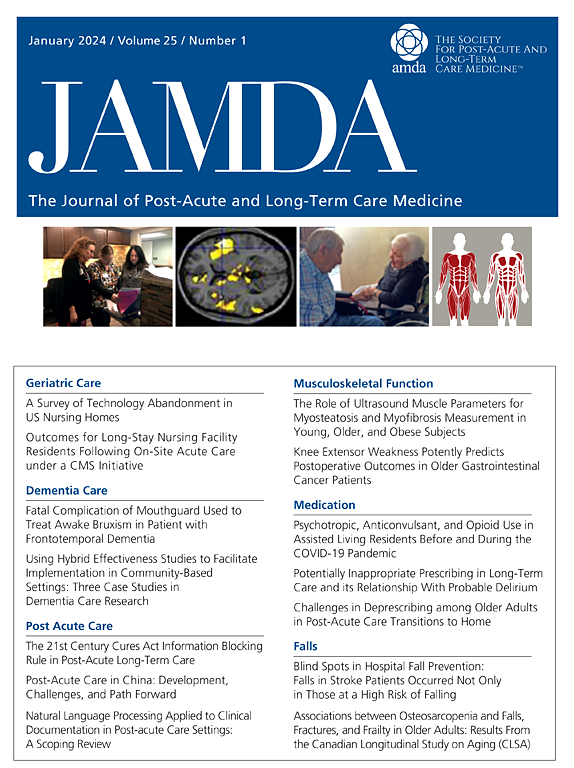Muscle Strength Comparison in Immune-Mediated Rheumatic Disease vs Healthy Adults: A Meta-Analysis
IF 4.2
2区 医学
Q2 GERIATRICS & GERONTOLOGY
Journal of the American Medical Directors Association
Pub Date : 2024-10-02
DOI:10.1016/j.jamda.2024.105293
引用次数: 0
Abstract
Objectives
Patients with immune-mediated rheumatic diseases (IMRDs) often exhibit reduced muscle strength. Therefore, this review aimed to evaluate muscle strength in patients with IMRDs compared with healthy control and to summarize the relationship between low muscle strength and clinical features in patients with IMRDs.
Design
Systematic review with meta-analysis of case-control studies.
Setting and Participants
Patients with IMRDs.
Methods
A comprehensive search was conducted in the Embase, MEDLINE, Web of Science, and Cochrane databases to identify relevant studies published up to November 2023 on rheumatoid arthritis, systemic lupus erythematosus, systemic sclerosis, and spondyloarthritis. Meta-analysis was performed using a random-effects model to determine the mean difference (MD) in muscle strength between patients with IMRDs and an age- and sex-matched healthy control group.
Results
We identified 11,692 studies, and 760 studies were selected for screening. Ultimately, 26 studies met the inclusion criteria, composed of 2661 individuals, mostly women. The IMRDs women group had lower handgrip muscle strength (MD, −9.53; 95% CI, −11.78 to −7.28 kg) than the healthy control group, whereas the handgrip strength men groups did not differ significantly from that of the healthy control group. Similar trend was observed in lower limb muscle strength for the IMRDs women group than the healthy control group (MD, −63.10; 95% CI, −94.18 to −32.01 Nm). Four studies examined muscle strength and clinical features in rheumatoid arthritis: one associated it with age and disease activity, 2 associated it with disease duration, and 3 associated it with physical function. In systemic lupus erythematosus, only 2 studies associated low muscle strength with age, disease activity, and fatigue. No associations were found in spondyloarthritis, and none were found in systemic sclerosis.
Conclusions and Implications
Patients with IMRD exhibit lower muscle strength than healthy counterparts, with low strength moderately associated with longer disease duration, worsening disease activity, and decline in physical function. Targeted interventions are crucial for preventing and managing muscle weakness in IMRDs.
免疫性风湿病与健康成人的肌肉力量比较:一项 Meta 分析。
目的:免疫介导的风湿性疾病(IMRDs)患者通常表现出肌肉力量减弱。因此,本综述旨在评估与健康对照组患者相比肌肉力量减弱的免疫介导风湿性疾病患者,并总结低肌肉力量与免疫介导风湿性疾病患者临床特征之间的关系:设计:对病例对照研究进行系统回顾和荟萃分析:环境和参与者:IMRD患者:在Embase、MEDLINE、Web of Science和Cochrane数据库中进行了全面检索,以确定截至2023年11月发表的类风湿关节炎、系统性红斑狼疮、系统性硬化症和脊柱关节炎的相关研究。采用随机效应模型进行了元分析,以验证IMRD患者与年龄和性别匹配的健康组之间的平均肌力差异(MD):我们确定了 11,692 项研究,筛选出 760 项研究。最终,26 项研究符合纳入标准,共纳入 2661 人,其中大部分为女性。IMRDs女性组的手握肌力(MD,-9.53;95% CI,-11.78 至 -7.28千克)低于健康组,而男性组的手握肌力与健康组没有显著差异。与健康组相比,IMRDs女性组的下肢肌力也出现了类似的趋势(MD,-63.10;95% CI,-94.18至-32.01牛米)。四项研究调查了类风湿性关节炎患者的肌肉力量和临床特征:一项研究将肌肉力量与年龄和疾病活动性相关联,两项研究将肌肉力量与疾病持续时间相关联,三项研究将肌肉力量与身体功能相关联。在系统性红斑狼疮中,只有两项研究将低肌力与年龄、疾病活动性和疲劳相关联。脊柱关节炎和系统性硬化症中没有发现任何关联:IMRD患者的肌力低于健康人,低肌力与病程延长、疾病活动恶化和身体功能下降有一定关系。有针对性的干预措施对于预防和控制IMRD患者的肌无力至关重要。
本文章由计算机程序翻译,如有差异,请以英文原文为准。
求助全文
约1分钟内获得全文
求助全文
来源期刊
CiteScore
11.10
自引率
6.60%
发文量
472
审稿时长
44 days
期刊介绍:
JAMDA, the official journal of AMDA - The Society for Post-Acute and Long-Term Care Medicine, is a leading peer-reviewed publication that offers practical information and research geared towards healthcare professionals in the post-acute and long-term care fields. It is also a valuable resource for policy-makers, organizational leaders, educators, and advocates.
The journal provides essential information for various healthcare professionals such as medical directors, attending physicians, nurses, consultant pharmacists, geriatric psychiatrists, nurse practitioners, physician assistants, physical and occupational therapists, social workers, and others involved in providing, overseeing, and promoting quality

 求助内容:
求助内容: 应助结果提醒方式:
应助结果提醒方式:


